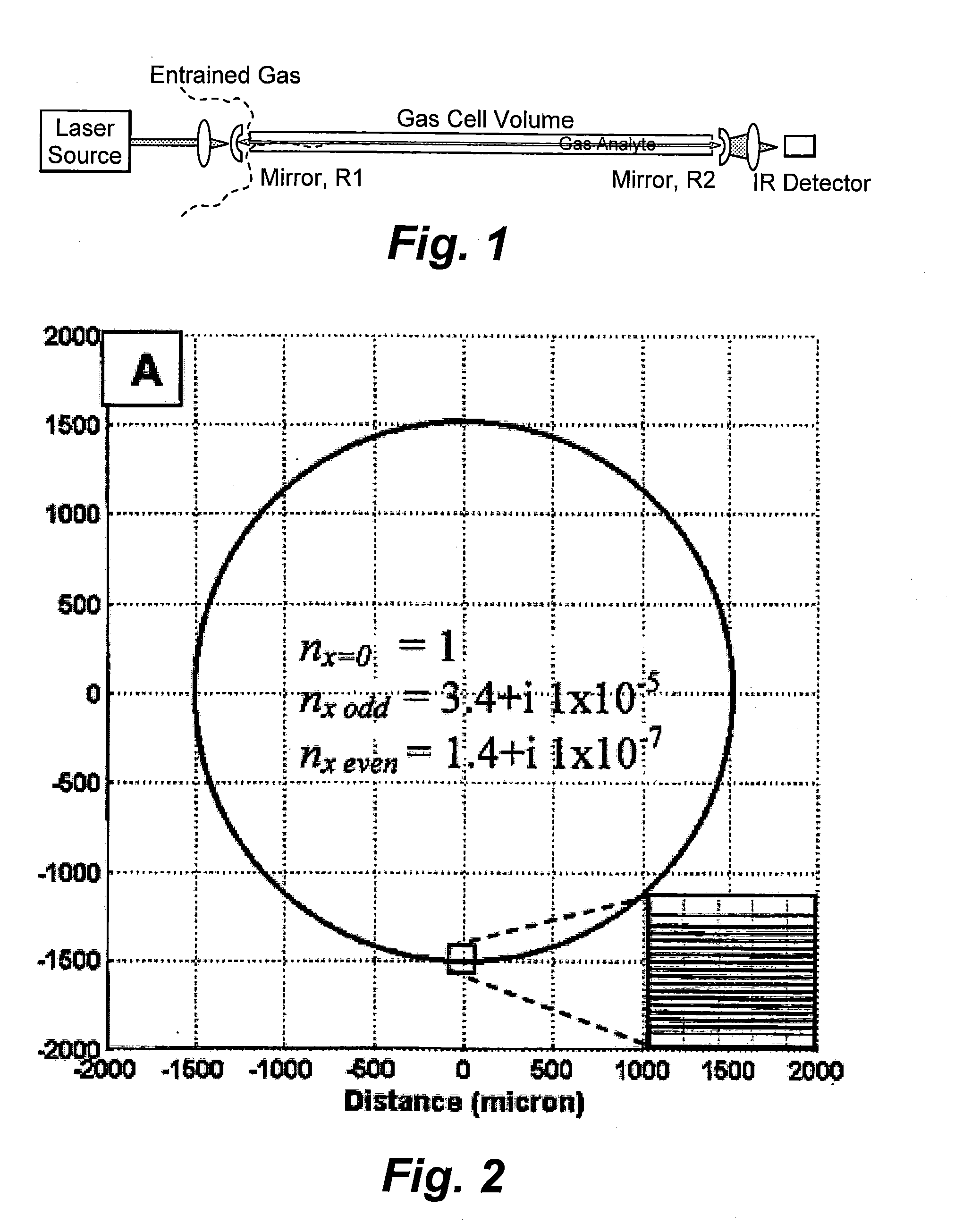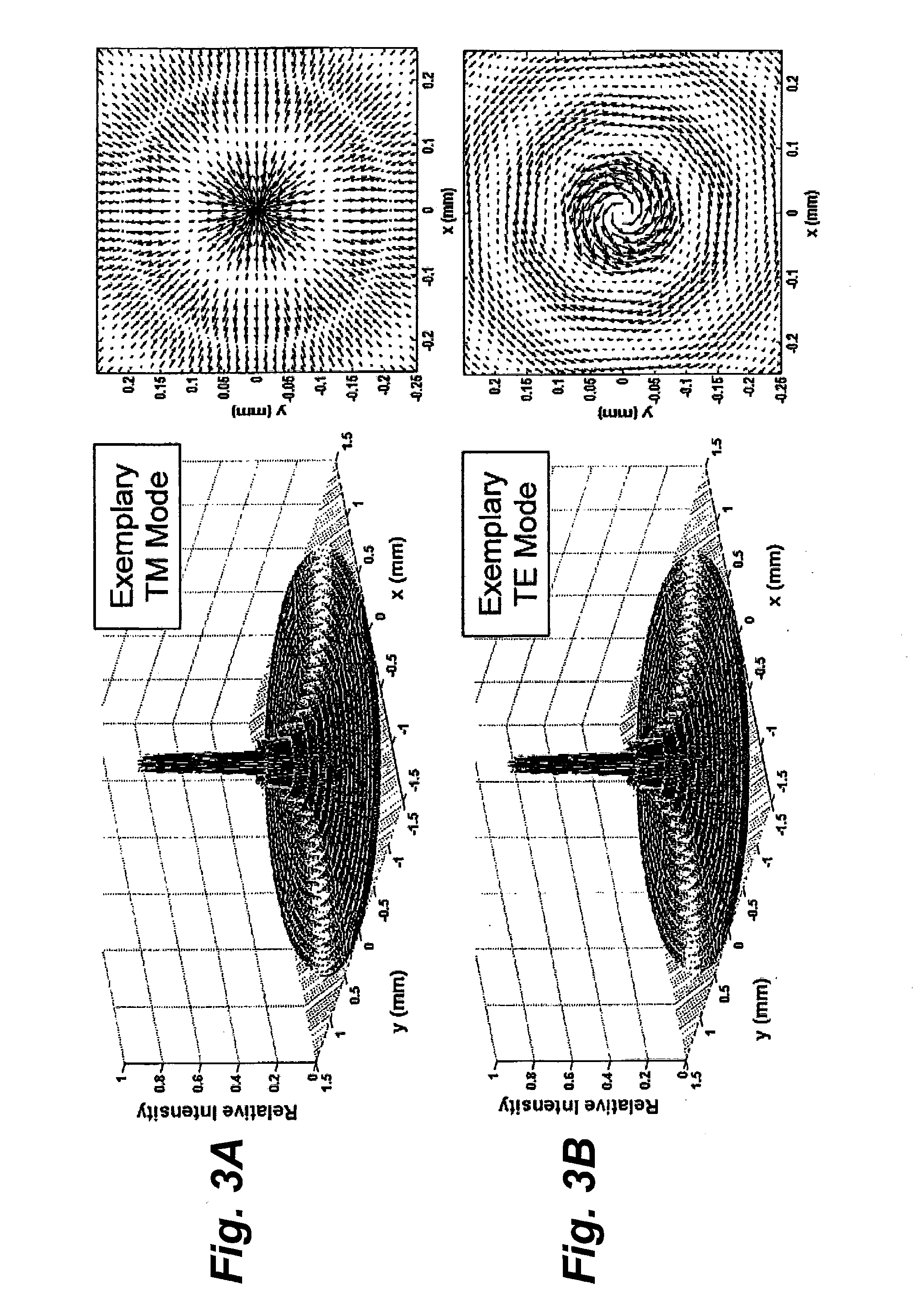[0008]A
hollow waveguide (HWG) is an optical structure with a
hollow core(s) or hollow cross-sectional structure that can be filled with a gas, liquid, or material of differing
dielectric properties than the
waveguide itself. The
waveguide serves to establish a
discrete set of transverse
electric field profiles (a.k.a.
modal fields) and guides these
modal fields along the axis of the waveguide (note waveguide does not necessarily need to be straight). Each
modal field has its own axial modal velocity which is correlated with the angle of bounce of a geometric
ray inside the waveguide. By careful design of the waveguide, light can be made to propagate axially along the waveguide with low attenuation losses of the modal fields. Two fundamental energy dissipative losses of the modal fields exist in the HWG: 1) Radial transmission through the “leaky” waveguide into the surrounding environment; and 2) Absorption losses in the waveguide itself and
hollow core (when filled with an absorbing medium). By careful selection of the real and complex refractive indices of the waveguide materials and geometry, the inherent dissipative losses in the HWG can be made sufficiently small to allow cavity ringdown laser
absorption spectroscopy to be conducted. The electric modal fields described herein are most commonly associated with optical wavelengths of light although waveguides can be scaled up to operate at longer wavelengths. Exemplary HWG's that have lower cavity attenuation losses (per round trip) than typical CRDS mirrors have been shown to be both theoretically and experimentally feasible. Therefore, HWG-CRDS is technically feasible.
[0009]The unique and novel hollow waveguide cavity ringdown spectroscopy (HWG-CRDS) design disclosed herein provides a substantial improvement in a number of areas associated with CRDS measurements of absorption between two CRDS mirrors and the design of a
cell that contains the absorbing medium. Aspects of the invention relate to measurement of loss mechanisms in an
optical cavity in general such as measurement of mirror
reflectivity, measurement of attenuation by an optic element of the
cell, measurement of scattering, absorption, or
extinction by a gas, liquid, or
solid phase suspended in the optical
cell or adhered to the walls of the cell. By the use of HWG-CRDS, several distinct advantages exist over conventional CRDS: 1) Sample volumes of the cell can be significantly reduced by containing the light
power flow in a highly constrained volume without significantly increasing cavity losses. In such a case, much smaller samples can be analyzed such as gases evolved from highly localized regions in a precision sampled volume, 2) Light can be injected through a mirror aperture and simultaneously contained within the cavity over the entire ringdown profile. a) This configuration would enable very large enhancements in injected cavity energy drastically reducing the laser power requirements for conducting Pulsed-CRDS (P-CRDS). b) For a given laser power using P-CRDS, this configuration would significantly improve any combination of measurement sensitivity and measurement time by enhancing the
Signal-to-
Noise (S / N) ratio of the CRDS measurement by up to a factor of 104. Pulsed-CRDS (P-CRDS) does not require precision length tuning of a cavity. 3) HWG supports mode propagation angles large enough such that precision tuning of a CRDS cavity could be conducted by altering the injection angle into the waveguide rather than mechanically tuning the cavity length. In such a case, precision length tuning of the cavity is not required. 4) HWG supports a large continuum of longitudinal
modes unlike an
open cell. Mode-beating behavior associated with a small set of supported
modes in an
open cell P-CRDS significantly limits the sensitivity of the P-CRDS measurement (particularly for
long pulse lengths greater than the round-trip time of the cavity). Mode-beating behavior may be drastically attenuated by excitation of a large distribution of HWG longitudinal modes, all with different modal velocities to enhance measurement sensitivity. 5) The configuration of the CRDS mirrors with the hollow waveguide is inherently more robust to
optical alignment variations particularly for low cost instrument development compared to an open cell configuration.
[0011]Pulsed CRDS (P-CRDS) is another version of CRDS that does not necessarily require precision tuning of the cavity. By removing the requirement for a precision tuned laser cavity at certain
wavelength spatial resolutions, the overall CRDS process is simplified and the cost of producing the apparatus that supports accurate measurements of gas concentrations is reduced. In the P-CRDS configuration, the length of the laser pulse of light is commonly restricted to ˜one roundtrip time of the cavity (for a 1 m cavity length this is ˜6.7 nanoseconds). As a result, P-CRDS is very sensitive to
coupling efficiency since cavity energy is not allowed to accumulate, but rather is limited to the energy contained in a very short pulse. P-CRDS cavity energy is fundamentally limited to the cavity mirror transmissivity. In another embodiment of the invention, the
laser light is made to enter the cavity by focusing onto a small spot on the surface of one mirror. The
high reflectivity coating is removed or otherwise absent at the laser focal spot, allowing the majority of the light to enter the cavity (transmission is increased up to 1.0 or up to 10,000 times greater than conventional CRDS). The waveguide contains this focused
light energy whereas in conventional open cell CRDS, the
light energy would be rapidly transmitted out of the cavity after a small number of mirror reflections. In this particular case, in order to minimize attenuation in the HWG, the propagation angle of excited modes may be kept shallow (<5 degrees). A trade-off in extremely shallow injection angles is the loss in
reflectivity in the entrance mirror as the F / # of the focusing optic increases (and aperture size due to focus spot size subsequently increases). The HWG is designed such that axial losses are small at the injected
light propagation angles where the CRDS measurement will be acquired.
[0012]In P-CRDS, the hollow waveguide allows propagation of a very large continuum of cavity modes including modes with high propagation angles, while conventional CW-CRDS allows transmission only at discrete
optical frequencies limited to very low propagation angles. To overcome the discrete frequency problem of conventional cavity-enhanced spectroscopy, the cavity length is varied causing the transmissive frequencies to shift. In accordance with at least some embodiments of the present invention, this will be unnecessary as the nature of the hollow waveguide and method of light injection is to allow a near continuum of light to propagate in the cavity at very low loss. In one embodiment of the invention, a large distribution of excited modal fields of different wavelengths can be simultaneously excited in the HWG and monitored with a high speed
spectrometer in order to determine a near instantaneous measurement of spectrally dependent absorption without requiring laser tuning. In such a design, the requirements on laser excitation source linewidth and tuning range are greatly reduced.
[0014]In open cell CRDS, the mode propagation angle is very small (near 0 degrees), the actual small angle dependent on the
radius of curvature of the end mirrors. Therefore, as previously discussed, to tune a
longitudinal mode of light into the cavity, the
wavelength of light in the cavity effectively needs to be resonant with the cavity length. In the HWG-CRDS technique, given the large propagation angles that are possible in the HWG, a
longitudinal mode (combination of
wavelength of light and propagation angle) must be resonant with the cavity. As such, instead of requiring the cavity length to be actively tuned, in HWG CW-CRDS, the cavity length can be passively fixed and instead the injection angle into the HWG can be precision tuned or alternatively a distribution of propagation angles can be excited by a
coupling optic. For a given
propagation constant that is resonant with the
fixed length cavity, there will be corresponding propagation angle(s) that is(are) resonant with the cavity for a specific wavelength of light such that even a
fixed length cell becomes wavelength tunable. In this case a large enough distribution of propagation angles needs to be excited to ensure there is a resonant propagation angle for any wavelength. In one embodiment of the invention, a coupling optic that modulates the injection angle (e.g. acousto-optic, thermally controlled
grating, piezoelectric
optical coupler) can be used to conduct CRDS or ICOS with a
continuous wave laser in an HWG instead of requiring mechanical length changes of the overall cavity. In another embodiment of the invention, a coupling optic excites a large enough distribution of mode propagation angles, a very small subset of which are actually resonant with the cavity for any given wavelength. The large continuum excitation of propagation angles coupled with the selectivity of resonant modes with
long pulse lengths approaching CW-CRDS in a
fixed length cavity ensures that the cavity is wavelength tunable without requiring mechanical length changes of the overall cavity.
 Login to View More
Login to View More  Login to View More
Login to View More 


